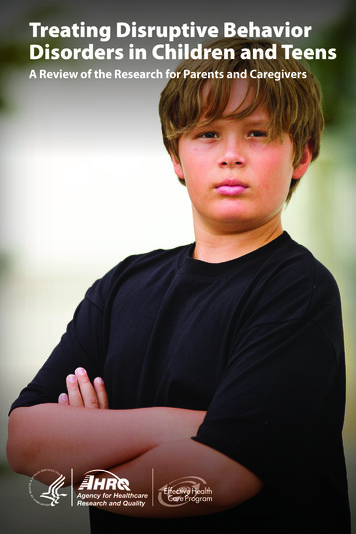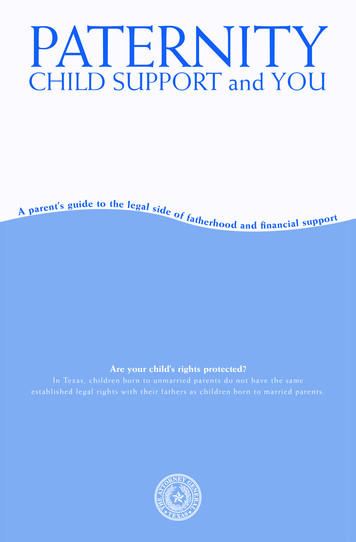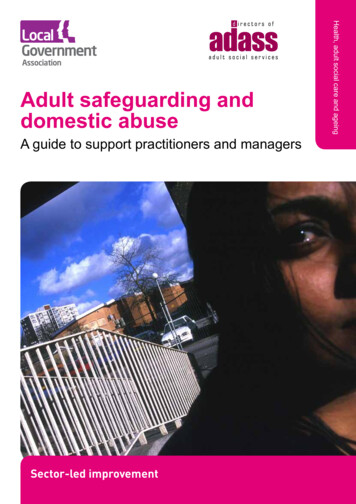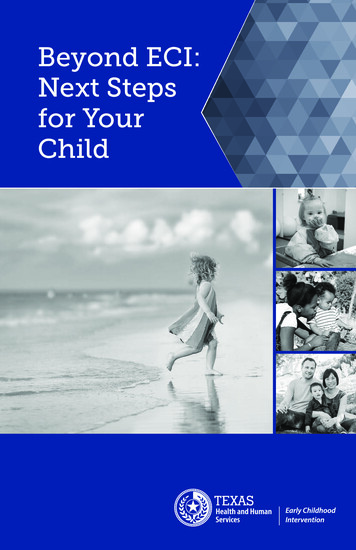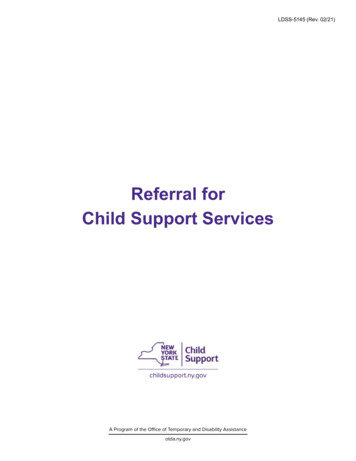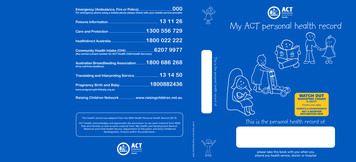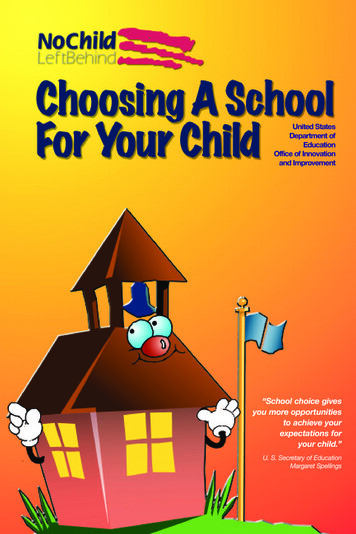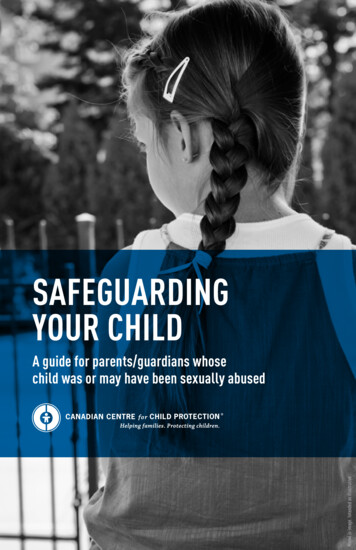
Transcription
SAFEGUARDINGYOUR CHILDModel in image. Intended as illustrative.A guide for parents/guardians whosechild was or may have been sexually abused
This booklet builds on Child Sexual Abuse: Picking up the Pieces and helps parents/guardians continue on the healing journey, addressing issues that may present as theirchild gets older. This includes rebuilding personal boundaries, addressing concernssurrounding supervision, considering their child’s digital presence as they grow up,and providing a basic understanding of child development to help parents/guardiansdetermine if sexualized behaviours are problematic or age appropriate.1SAFEGUARDING YOUR CHILD2AS YOUR CHILD DEVELOPS3THE ROLE OF PERSONAL BOUNDARIES9SUPERVISION AND SAFEGUARDING12SAFEGUARDING YOUR CHILD WHEN OUTSIDEYOUR CARE16SAFETY WITH INTERNET-ENABLED DEVICES22TYPICAL CHILD SEXUAL BEHAVIOUR(4-12 YEARS OF AGE)26TEACH YOUR CHILD ABOUT PERSONAL SAFETY28REFERENCES AND RECOMMENDED READINGAll content and design (except stock photos) 2018, Canadian Centre for Child Protection Inc. (the “Canadian Centre”), 615 AcademyRoad, Winnipeg, Manitoba, Canada. All rights reserved. Stock photos are used under license from Getty Images. No one is permittedto post all or any part of this book online. Individual users may make and use a personal copy of it, and those who work with survivorsof sexual abuse may make and share copies of it with their clients provided no commercial use is made of it or the content. Other thanthe above permissions, no person may make copies of this booklet (in whole or in part, in print or electronic form), store it in a retrievalsystem, or transmit it in any form or by any means, electronic, mechanical, photocopying, recording or otherwise for, any reason.This is a publication of the Canadian Centre for Child Protection Inc., a charitable organization dedicated to the personal safetyof all children. Registered charity number: BN#106913627RR0001. Visit us at protectchildren.ca.August 2018ISBN: 978-1-988809-44-1 (print version)ISBN: 978-1-988809-48-9 (electronic version)“CANADIAN CENTRE for CHILD PROTECTION” is registered in Canada as a trademark of, and “Cybertip.ca ALERTS!” is used as atrademark of, the Canadian Centre for Child Protection Inc.Model in image. Intended as illustrative.The information contained in this publication was prepared by staff of the Canadian Centre for Child Protection Inc. Allinformation herein is of a general nature and is not intended as advice. Readers should assess all information in light of theirown circumstances, the age and maturity level of the child they wish to protect, and any other relevant factors.
CANADIAN CENTRE FOR CHILD PROTECTIONSAFEGUARDING YOUR CHILDWhen a child experiences child sexual abuse, it impacts theentire family. Discovering that your child has experiencedabuse is devastating. It can leave you feeling lost aboutwhat to do now and how to help your child.The information provided in this guide is intended tosupport you in your parenting journey and to promotehealing for your family. There are some areas that requirecloser consideration when your child has experiencedsexual abuse. As such, topics covered in this guide includepersonal boundaries, adult supervision, children’s use ofinternet-enabled devices, and child sexual behaviours.Establishing healthy personal boundaries and providingage-appropriate supervision are pivotal to helping yourchild restore a sense of security.TRUTHSParents sometimes worry that their child will never be the sameand will forever be identified solely as a survivor of abuse. It is anexperience they have had, but it does not define who they areor will be. They are, and will be, so much more than their abuseexperience.Remember: Healing is possible. Healing is a process that takes time. During the healing process, it is common for children tohave good days and bad days. Children may feel like they arespinning in circles one day, feeling good the next day, and thenfeeling back to where they started the following day.1
SAFEGUARDING MY CHILDAs Your Child DevelopsWhen a child experiences sexual abuse they may develop copingbehaviours in order to manage from day to day. As a parent/caregiver,it can be difficult to know what is typical for your child’s developmentand what is a result of their abuse experience. Constantly wonderingwhether your child’s behaviour is typical or abuse-related not onlyadds a great deal of stress, but can actually interfere with your abilityto respond appropriately to the behaviour.As emotional, psychological, and/or physical effects can show upat new stages in a child’s development, it is important to consultwith your primary care provider and/or counsellor at each newdevelopmental stage. As your child grows up, you (and your child)may need help understanding and managing new information.Your primary care provider and/or counsellor can provide bothsupport and recommendations to help your child move througheach stage successfully.Models in image. Intended as illustrative.2
CANADIAN CENTRE FOR CHILD PROTECTIONThe Role of PersonalBoundariesA child’s experience of sexual abuse can impair their understandingof personal boundaries. As a result, children who have been abusedmay find it difficult to set their own personal boundaries and torespect the boundaries of others. When sexual abuse occurs,inappropriate behaviour is distorted and normalized. If boundarieshave been impaired, you may notice that your child: Is overly quick to trust, builds intense relationshipswith new people, and is accepting of whatever informationis shared Is mistrusting, which prevents them from engagingwith others Does not demonstrate separate boundaries fromothers, which can be expressed as being excessivelyaccommodating to whatever others want to do withoutconsideration for their own limits or comfort level Does not show respect for privacy for themselves or others Does not respond to limits placed on behaviour or whenothers attempt to re-direct behaviour3
4SAFEGUARDING MY CHILDDISCUSSING BOUNDARIES WITH CHILDRENProvide GuidanceWhen a child has difficulty with boundaries there is no quick fix.To begin to repair their sense of personal boundaries, children needto learn and practice self-protection skills. Helping them build theirconfidence and sense of self takes a lot of patience and practice.It requires on-going, consistent and gentle behavioural redirection,modelling, and praise. Point out to your child when others areappropriate with personal boundaries, as well as when theydemonstrate appropriate social, emotional, or physical boundarieswith others.Practice What You PreachHealthy boundaries are the key to a child’s sense of safety andsecurity. Children rely upon the guidance and judgment of adults tokeep them safe. If you are uncomfortable with the way an adult isinteracting with your child or another child, do something about it.Adults who respect children’s personal boundaries help reinforcehow children should expect to be treated. When adults demonstrateunhealthy boundaries with children, it compromises their sense ofsafety and security.Healthy adult behaviour with children includes: Being friendly, not friends Respecting a child’s limits Modelling healthy personal boundaries (e.g., changing,sleeping, bathing, possessions, thoughts, and emotions) Re-establishing boundaries when kids push the limits
Models in image. Intended as illustrative.CANADIAN CENTRE FOR CHILD PROTECTIONExplaining BoundariesPersonal boundaries are broken into four areas that include:1Physical boundaries:Respecting our bodies and our personal belongings, and thoseof others.Examples of adults crossing physical boundaries:ww Insisting children hug or kiss othersww Being excessively affectionate and ignoring achild’s signs of discomfortww Exposing a child to violence and aggression5
SAFEGUARDING MY CHILDModel in image. Intended as illustrative.62Emotional boundaries:Respecting our private thoughts and feelings, and those of others.Examples of adults crossing emotional boundaries:ww Using shame (e.g., “I can’t believe you would do that!What kind of a person are you?”)ww Using sarcasm (e.g., “Way to go Einstein. A 2-year-oldknows how to do that.”)ww Using guilt (e.g., “I do so much for you. Can’t you dothis one thing for me?”)ww Demeaning someone (e.g., “You may as well quit. Youhave no talent anyway.”)ww Placing a child in a role as an adult’s confidant/bestfriend (e.g., confiding about financial problems orrelationship problems)ww Body shaming (e.g., “You’re fat.” “Look at thatstomach.”)
CANADIAN CENTRE FOR CHILD PROTECTION3Sexual boundaries:Understanding sexual consent (including in relation to the ageof protection/consent), and the harm of exposure to sexuallyexplicit content.Examples of adults crossing sexual boundaries:ww Telling a child sexual jokesww Showing a child sexually graphic picturesww Sharing adult-level sexual information with or arounda childww Engaging in sexual activity in the presence of a childww Watching pornography in the presence of a childww Sending sexual pictures, texts, or emails to a childww Engaging in sexual activity with a child4Social boundaries:Adjusting our interactions with others depending on the type ofrelationship or roles we have with them.Examples of adults crossing social boundaries:ww Repeatedly using poor judgment when interactingwith childrenww Asking personal questions to people they do not knowwellww Embarrassing, humiliating, or shaming a child infront of othersww Walking in on someone changingww Sending or posting personal pictures of othersww Distorting a child’s views of other adults in their life7
8SAFEGUARDING MY CHILDNote: Be respectful and follow your child’s lead as they begin to seek privacyand start to feel embarrassed being naked or bathing in front of you.Responding to Concerns when a Boundary is BrokenIf you, or your child, feel uncomfortable because of an interactionwith an adult (e.g., an adult makes an inappropriate sexualizedremark to the child), let the adult know you are not comfortablewith what transpired and re-establish boundaries between themand your child.Model in image. Intended as illustrative.People often question themselves or are reluctant to talk aboutsituations or relationships they question between an adult and achild. They want to avoid interfering or meddling. There may be anelement of discomfort in raising your concerns; however, by doing soyou are showing your child they have the right to establish their ownboundaries and be treated with respect.
CANADIAN CENTRE FOR CHILD PROTECTIONSupervision and SafeguardingSupervision is a key element in the personal safety of all children,but is even more necessary for children who have experiencedsexual abuse. Children who have experienced sexual abuse havean increased vulnerability for re-victimization because theirboundaries and development have been disrupted. Because suchdisruptions can impair their capacity to self-protect, parents andcaregivers need to establish a more protective environment fortheir children. This means direct adult supervision and supportfrom many parties is needed.During the healing process:123Establish a team of people to be a part of the child’s safety circle.This may include family members, school personnel, friends, atherapist, your health care provider, victim services workers, lawenforcement, etc.Pay attention to internet use and mobile devices. With technologyso seamlessly woven into the lives of children, adult supervisionis critical. It is important to understand the capabilities ofthe technology your child is using, and the associated safetyconsiderations.Provide a safe and supportive environment for the child. This isessential for helping to restore their personal boundaries andstrengthen their self-protection skills.9
SAFEGUARDING MY CHILDModels in image. Intended as illustrative.10Supervision and Stages of DevelopmentParental supervision is fundamental to protecting children becauseit provides safety, support, predictability, and structure in children’slives. Balancing children’s needs for independence and safety isdifficult. While you want to avoid being over protective, you also do notwant to be under protective. This balance needs to be revisited andadjusted often. While required levels of supervision will vary basedon the age and needs of individual children, what follows are generalsupervision guidelines.4 to 6 years old:Direct supervision is required, and children should always be in view whenplaying in the backyard, on the street, at the playground, in the house, etc.7 to 10 years old:Direct and indirect supervision is required. As children begin to have playdates at friends’houses and are under the supervision of others, build in check-in times to connect withthem while they are away. This will allow for indirect supervision and monitoring.
CANADIAN CENTRE FOR CHILD PROTECTION1111 to 12 years old:Children start seeking more independence. Parental supervision and makingyourself visible is important, but will often be less direct. Know where they are,what they are doing, who they are with, and build in regular check-in times.Make yourself visible when children have friends over and keep an ear open towhat is going on.13 to 16 years old:As youth begin to separate from parents and peers have increased influence,parental supervision, monitoring, and making yourself visible continue to beimportant. Adolescence is a time of increased vulnerability for sexual harassmentand abuse from peers and others. For youth, this can include sexting or sextortion.1Keep tabs on where they are, who they are with, and build in check-in times. Bepresent when they have friends over so you can check in on them. Supervisionhelps keep behaviour in check and reduces the likelihood of children makingunsafe choices that might result in an unsafe or harmful situation.Phippen, A. (2012). Sexting: An exploration of practices, attitudes and influences.London, UK: NSPCC; Bush, M. & Russell, L. (2016). Resilience for the Digital World.London, UK: YoungMinds and Ecorys.Models in image. Intended as illustrative.1
12SAFEGUARDING MY CHILDSafeguarding Your ChildWhen Outside Your CareThere are important considerations for ways to safeguard your childwhen they are not in your care. These include being aware of theprotective practices and appropriate behaviour guidelines withinprograms and services in which your child is participating.Selecting BabysittersImportant considerations: Avoid posting ads or searching for babysitters online. Inquire about babysitters known within the neighbourhood. Speak to other people who have hired the babysitter. If possible, meet with the babysitter and their parents. Have the babysitter over a few times to play with your childwhen you are home. Consider setting parameters (e.g., the babysitter does notbathe or change your child into their pajamas; you do thatbefore you leave, the babysitter does not take pictures or videosof the child with personal devices). Call and speak to your child before bed. If you are notable to call, arrange for someone else to do so (such as agrandparent). Your child needs a built in check-in whileyou are out.
13Models in image. Intended as illustrative.CANADIAN CENTRE FOR CHILD PROTECTIONSelecting Programs and ActivitiesImportant considerations: What steps does the organization take to screen employees/volunteers? What strategies, policies, and safety plans does theorganization have in place for:ww Transportation of children?ww One-on-one time with children?ww Changing and showering needs?ww Overnight trips?ww Communication with children/family outside programactivities (including texting, emailing, using socialnetworking sites)?ww Picture taking?ww Any extended contact staff may have with children outsideof their role? How does the organization communicate issues or concernsto parents when an incident or situation takes place?For more information, visit commit2kids.ca.
SAFEGUARDING MY CHILDModels in image. Intended as illustrative.14Arranging Playdates and SleepoversImportant considerations: Who is supervising the kids? Will anyone else be there (e.g.,houseguests)? Establish check-in times where you call to speak withyour child. Establish a signal for your child to communicate to you if theywant to come home. Signals might include your child phoningyou to tell you they have a headache or stomach pain, or anagreed upon text message. Make arrangements so they can be picked up at any time. Let your child know it is okay if they decide they want to comehome.As your child increases time away from home playing atfriends’ houses establish check-in times where you cancall to speak with them.
15Models in image. Intended as illustrative.CANADIAN CENTRE FOR CHILD PROTECTIONHelping Your Teen Safely Seek Babysitting JobsImportant considerations: Avoid posting online or responding to online ads. Inquire about babysitting jobs connected to people known byothers within the neighbourhood. Collect information about where they are babysitting, theaddress, and have a way to contact them while they are there.Meet the parent if you can. Be available for your teen to contact you or someone in theirsafety circle in case they have questions and need supportwhile babysitting.
16SAFEGUARDING MY CHILDSafety withInternet-enabled DevicesHow your child develops their online presence and uses theinternet requires parental involvement. If your child’s abuse wasrecorded and shared online, safeguarding them from overexposureonline is necessary. While most experiences children have on theinternet are positive, it is still necessary for parents to be awareof the risks and what to teach children about encountering unsafesituations online.Your child’s online presence needs careful monitoring and accessto online apps needs to be controlled to reduce their risk ofre-victimization. Consider the following: Be selective about the information shared about your child onsocial media and how recognizable your child is in order toreduce the risk of the information being misused by others. Some social media platforms have sections where you canpost a bio, all of which may be public, even if the accountitself is set to private. Many youth use that section topost usernames for other social media where they canbe contacted (or age, location, name of school, or phonenumber), so check this as well.pTip: Pay attention to excessive time spent in the bathroom.Reports processed by Cybertip.ca indicate many nudeselfies of teens are taken in the bathroom mirror.
17Model in image. Intended as illustrative.CANADIAN CENTRE FOR CHILD PROTECTIONCommunication with OthersTo increase your child’s safety online and reduce opportunities forvictimization: Reassure your child that they can come to you for help or todiscuss any situation they encounter. Discuss ways to get out of uncomfortable conversations orsituations online. Review and try out any apps your child is using to ensure theyare age appropriate. Ensure that you understand how the safety controls of theapps work and how they can be enabled/disabled. Avoid apps that do not have privacy/safety controls. Limit your child’s access to social media and do not allowthem to create their own accounts without your oversight. Ensure you are involved in setting up the controls for each ofyour child’s social accounts.
SAFEGUARDING MY CHILD Restrict all of your child’s social accounts to friends they knowin person to reduce access to the account from others they donot know. Regularly review apps to ensure you are implementing anynew privacy/safety controls available. Supervise online activity. Have regular conversations about safety risks and strategies. Discuss the risks of having sexually explicit conversationswith people online or meeting up with someone in person whothey first meet online (ages 10 and up).* Discuss that pornography they may come across online isnot realistic, nor a reflection of a healthy sexual relationship(ages 10 and up).*Models in image. Intended as illustrative.18Sign up forto stay on top ofthe concerning online trends impacting the personal safety ofchildren and youth.* Age 10 is an approximate age only, and it is expected caregivers will exercise discretionbased on their child’s level of maturity.
CANADIAN CENTRE FOR CHILD PROTECTION19Online GamesOther areas to monitor are online games and gaming consoles thatare internet-enabled. Consider the following: Take interest in what your child is doing online instead of justsaying “no.” For consoles, set up parental controls and create passwords forthe parental control features. You can control online access byusing the block and/or restrict features available on most videogame consoles. Know your child’s passwords, screen names, and the friendsthey are playing against and chatting with. Review games to ensure they are age appropriate. Review the game’s guidelines and see if there is an option toreport inappropriate activity. Consider differences in features between the desktop and appversions of the game. Seek games that offer the ability to block or restrict individualswho can play with your child and allow you to mute otherindividuals from chatting with them. Consider the additional risks if the game has a chat feature andwhether it’s open chat or users send private messages.Model in image. Intended as illustrative. Discuss the risks of meeting people online. Others can easilymisrepresent themselves even if the game is intended for aspecific age group.
SAFEGUARDING MY CHILDExposure to Sexually Explicit MaterialSome children who have experienced sexual abuse may have beenexposed to sexually explicit material as part of the abuse process.For some children this material has been normalized and as suchthey may continue to seek it out online. Some children whoseabuse has been recorded may be particularly sensitive and upset byexposure to pornography or by others looking at pornography.Keep in mind that pornography is readily available and unregulatedonline. About one in three children is exposed to pornography by theage of 10.2 This can be confusing and distressing for children as theyare not developmentally ready to process such explicit material.Stay calm and let your child know you understand how this canhappen while online and that they can come to you if this happensto them. Let them know that they will not be in trouble. Sometimeschildren are too embarrassed to talk to their caregivers aboutsensitive topics, and this is where a circle of safe adults is helpful.2Model in image. Intended as illustrative.20Skau, B. (2007). Who Has Seen What When? Pornography’s Contribution to theSocial Construction of Sexuality During Childhood and Adolescence. Theses andDissertations (Comprehensive). 1044.
CANADIAN CENTRE FOR CHILD PROTECTIONConduct OnlineAs children and youth begin to seek intimacy and closerrelationships, technology is often incorporated to bridge thecommunication between peers. Behaviour is generally less restrictedonline, which can lead to sexual experimentation, including sendingsexual pictures or sexual video chatting. Once images/videos areshared with others, control is lost and the media can easily be sent toothers without consent.Children and teens who have experienced childhood sexual abusemay be more vulnerable to being coerced and manipulated tosend sexually explicit content. Children may worry about othersrecognizing them online or be triggered by being asked for “sexy”pics. Sexually explicit pictures or recordings of children under 18are typically illegal, and any device or online program that enablescommunicating, recording, or sharing photos requires supervision.Safety suggestions include: Supervise and monitor all internet-enabled devices. Discuss the risk of losing control of material that is sharedonline and how easily it can be misused.pTip: Disable Wi-Fi at a specified time each evening so alldevices are restricted. This fosters a healthy balance withinternet use, promotes healthy sleeping routines, andreinforces parental supervision and monitoring.Note: It is important not to blame children for being responsive to attentionand affection as this is understandable. No child has the capacity to realizethe full scope of what they are getting into when they are engaging with anadult who is attempting to manipulate them.21
22SAFEGUARDING MY CHILDTypical Child Sexual Behaviour(4-12 years of age)While some children who have experienced sexual abuse maynot exhibit any behavioural changes, some may begin to act outproblematic sexual behaviour. A basic understanding of typicalchild sexual development will help you recognize when certainbehaviour may be concerning.Children 4–5 Years of AgeThe sexual development of preschool children is typically basedon learning and curiosity, including exploring their own bodies andother preschool children’s bodies (e.g., looking at private parts,pulling pants down). This type of activity is typically brief, with youngchildren being easily redirected if the other child shows little interest.This behaviour is generally not about sexual pleasure since sexualpleasure is beyond their level of development.If, however, preschool children have knowledge or information aboutsexual activity (i.e., what it feels, sounds, tastes, smells, or lookslike), it is more likely that they have learned this information throughexposure or experience. Gently establish boundaries so they are notoverexposing other children to that level of information.Note: While children do not understand it, they may experience sexualpleasure. Carefully consider how you talk to children about sexualbehaviour to avoid inciting shame.
CANADIAN CENTRE FOR CHILD PROTECTION23Additional concerning behaviour includes forcingother children to take their clothes off and/orengage in sexual games (for example, one childthreatens to hit another child if they don’t pulltheir pants down). This behaviour happens whenchildren have somehow linked aggression withsexual behaviour in their minds. This is usually alearned behaviour.Keep in mind that it’s typical to see coercivebehaviour in all areas of preschool development(e.g., social development, language development)and it’s important to correct such behaviourearly on. When coercive behaviour is combinedwith sexual behaviour, the situation should beaddressed promptly.Children 6–12 Years of Age From 6 to 8 years of age, it is typical forchildren to seek privacy. Beyond the age of 8, children graduallymove into a time of exploration. While sexualcuriosity is present, children become veryself-conscious about their behaviour.At this stage, sexual exploration is typically abouta mutual curiosity that involves hugging, kissing,and/or games such as, “I’ll show you mine, ifyou show me yours.” Typical behaviour for thisstage does not include engaging in adult sexualbehaviours, such as penetration or using themouth on someone else’s genitals.Model in image. Intended as illustrative. Children between 10 and 12 begin havingcrushes and become more concerned aboutbody image. They can also develop an intenseadmiration for adults of the same sex.
SAFEGUARDING MY CHILDModel in image. Intended as illustrative.24Similar to preschool children, coercive-based sexual behaviour inschool-aged children is also a cause for concern. If two schoolaged children are engaging in sexual behaviour it is important todetermine the details surrounding exactly what occurred and thedynamics between the children.pTip: If children are engaging in sexually inappropriatebehaviour, don’t overreact. Stay calm, gently teach themit is not appropriate behaviour, and redirect them. This canbe done through supervision of play with other childrenwhere adults set boundaries in a friendly and simple way.When adults yell or get angry with children for sociallyinappropriate behaviour, they can inadvertently reinforcethe exact behaviour they are trying to change.Note: While it is far more common to have older children engage youngerchildren in inappropriate sexual behaviour, it is possible to have the reverse.
CANADIAN CENTRE FOR CHILD PROTECTIONSelf-Stimulation versus MasturbationSelf-stimulation is a normal behaviour for children. It is important tounderstand that for prepubescent children, self-stimulation is a selfsoothing behaviour—the motivation being self-comfort/regulationand not sexual arousal. A child may have a variety of worries thatresult in self-soothing (e.g., the child generally has anxiety, the childisn’t feeling well, a significant person in the child’s life is ill).There would be concern around self-stimulating behaviour if theaction appears to be persistent and is interfering with a child’s dailyactivities. If a child is engaging in self-soothing behaviour, usuallythey can be easily redirected. If, on the other hand, it is difficult toredirect a child, then outside help may be needed.It makes sense to consult with your health care provider and/orcounsellor to manage the behaviour if it is interfering in your child’sdaily activities.To help your child establish their own personalboundaries and learn about their own privacy and theprivacy of others consider the following: Does your child sleep in their own bed? Does your child have their own bedroom or a spacefor their personal items? Does your child have privacy when using thebathroom? Is your child exposed to adult sexuality (in person orthrough the media)? Is your child exposed to violence (in person orthrough the media)? Does your child play with older children who are at adifferent stage of development?25
26SAFEGUARDING MY CHILDTeach Your Child AboutPersonal SafetyTeach your child to:Take ownership of their body.Once your child is able, teach them to dress, bathe, wash, and use the toileton their own. This will teach your
1 safeguarding your child 2 as your child develops 3 the role of personal boundaries 9 supervision and safeguarding 12 safeguarding your child when outside your care 16 safety with internet-enabled devices 22 typical child sexual behaviour (4-12 years of age) 26 teach your child about personal safety 28 references and recommended reading model in image. intended as illustrative.
